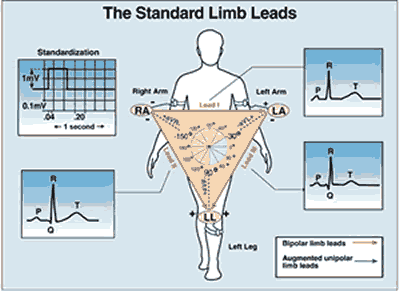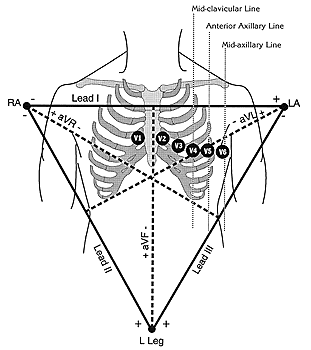|
|
|
|
|
|
|
|
|
|
|
|
|
Take the Test |
The standard 12-lead electrocardiogram is a representation of the heart's electrical activity recorded from electrodes on the body surface. This section describes the basic components of the ECG and the lead system used to record the ECG tracings.
Topics for study:
 click to view |
This diagram illustrates ECG waves and intervals as well as standard time and voltage measures on the ECG paper. |
What do they mean?
It is important to remember that the 12-lead ECG provides spatial information about the heart's electrical activity in 3 approximately orthogonal directions:
| Left | ||
| Inferior | ||
| Posterior |
Each of the 12 leads represents a particular orientation in space, as indicated below (RA = right arm; LA = left arm, LF = left foot):
Lead I: RA (-) to LA (+) (Right Left, or lateral)
Lead II: RA (-) to LF (+) (Superior Inferior)
Lead III: LA (-) to LF (+) (Superior Inferior)
Lead aVR: RA (+) to [LA & LF] (-) (Rightward)
Lead aVL: LA (+) to [RA & LF] (-) (Leftward)
Lead aVF: LF (+) to [RA & LA] (-) (Inferior)
Unipolar (+) chest leads (horizontal plane):
Leads V1, V2, V3: (Posterior Anterior)
Leads V4, V5, V6:(Right Left, or lateral)
Behold: Einthoven's Triangle! Each of the 6 frontal plane leads has a negative and positive orientation (as indicated by the '+' and '-' signs). It is important to recognize that Lead I (and to a lesser extent Leads aVR and aVL) are right █left in orientation. Also, Lead aVF (and to a lesser extent Leads II and III) are superior █inferior in orientation. The diagram below further illustrates the frontal plane hookup.

LOCATION OF CHEST ELECTRODES IN 4TH AND 5TH INTERCOSTAL SPACES:

V1: right 4th intercostal space
V2: left 4th intercostal space
V3: halfway between V2 and V4
V4: left 5th intercostal space, mid-clavicular line
V5: horizontal to V4, anterior axillary line
V6: horizontal to V5, mid-axillary line